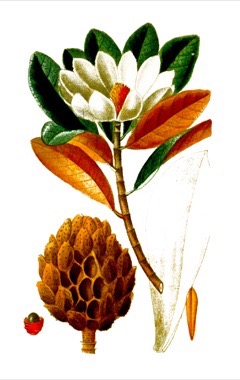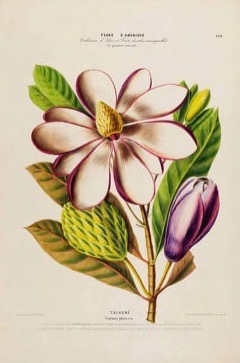 |
|
http://www.edibleplants.org |
 |
| http://www.edibleplants.org |
Translate this page:
Summary
Found in the Carribean, Magnolia dodecapetala is a 40 m tall tree with a large rounded canopy. It has a straight, cylindrical buttressed trunk that can be up to 90 cm in diameter and branchless for up to 18 m. It has no reported medicinal and edible uses. The wood is hard strong, and durable. It is highly valued as flooring material and for small boat construction and in the hulls of fishing canoes.
Physical Characteristics

 Magnolia dodecapetala is an evergreen Tree growing to 35 m (114ft) by 30 m (98ft) at a slow rate.
Magnolia dodecapetala is an evergreen Tree growing to 35 m (114ft) by 30 m (98ft) at a slow rate.
See above for USDA hardiness. It is hardy to UK zone 10.
Suitable for: light (sandy), medium (loamy) and heavy (clay) soils and prefers well-drained soil. Suitable pH: mildly acid, neutral and basic (mildly alkaline) soils. It cannot grow in the shade. It prefers moist soil.
UK Hardiness Map
US Hardiness Map
Synonyms
Annona dodecapetala Lam. Magnolia fatiscens Rich. ex DC. Magnolia linguifolia L. ex Descourt. Magnol
Plant Habitats
Edible Uses
References More on Edible Uses
Medicinal Uses
Plants For A Future can not take any responsibility for any adverse effects from the use of plants. Always seek advice from a professional before using a plant medicinally.
None known
References More on Medicinal Uses
The Bookshop: Edible Plant Books
Our Latest books on Perennial Plants For Food Forests and Permaculture Gardens in paperback or digital formats.

Edible Tropical Plants
Food Forest Plants for Hotter Conditions: 250+ Plants For Tropical Food Forests & Permaculture Gardens.
More

Edible Temperate Plants
Plants for Your Food Forest: 500 Plants for Temperate Food Forests & Permaculture Gardens.
More

More Books
PFAF have eight books available in paperback and digital formats. Browse the shop for more information.
Shop Now
Other Uses
Furniture Wood
Other Uses The heartwood is dull dark brown or black, often streaked with shades of brown; it is sharply demarcated from the white to light yellow sapwood. The texture is fine; the grain straight; when seasoned it is without distinctive odour or taste[378 ]. The wood is reported to be hard, tough, and strong, there are mixed reports on durability with some saying the heartwood is never attacked by insects, whilst others say that it is susceptible to termite and fungus attack[378 ]. The timber is also reported to be resistant to shock, stress, compression, and tension, and is difficult to split or twist. Its elasticity is also reported as fairly good[378 ]. The wood works easily and well, but does not take nails or screws well[378 ]. The wood is prized for flooring because of it's stability and the variety of colours present in the heartwood; it is also used extensively in small boat construction and in the hulls of fishing canoes. Other uses include marquetry, interior finish, gunstocks, and furniture[378 ].
Special Uses
References More on Other Uses
Cultivation details
References Carbon Farming Information and Carbon Sequestration Information
Temperature Converter
Type a value in the Celsius field to convert the value to Fahrenheit:
Fahrenheit:
The PFAF Bookshop
Plants For A Future have a number of books available in paperback and digital form. Book titles include Edible Plants, Edible Perennials, Edible Trees,Edible Shrubs, Woodland Gardening, and Temperate Food Forest Plants. Our new book is Food Forest Plants For Hotter Conditions (Tropical and Sub-Tropical).
Shop Now
Plant Propagation
Seed -
Other Names
If available other names are mentioned here
Bwapen mawon
Native Range
Coming Soon
Weed Potential
Right plant wrong place. We are currently updating this section.
Please note that a plant may be invasive in one area but may not in your area so it's worth checking.
Conservation Status
IUCN Red List of Threatened Plants Status : Status: Vulnerable B1ab(iii)

| Related Plants
|
| Latin Name | Common Name | Habit | Height | Hardiness | Growth | Soil | Shade | Moisture | Edible | Medicinal | Other |
| Liriodendron tulipifera | Tulip Tree, Tulip Poplar, Yellow Poplar, Canary Whitewood | Tree | 30.0 |
4-9
| M | LMH | N | M | 1 | 2 | 3 |
| Magnolia acuminata | Cucumber Tree, Cucumber Magnolia | Tree | 20.0 |
3-8
| M | LMH | SN | M | 0 | 3 | 2 |
| Magnolia campbellii | | Tree | 20.0 |
7-10
| | LMH | SN | M | 0 | 0 | 2 |
| Magnolia denudata | Lily Tree, Yulan Magnolia | Tree | 10.0 |
5-9
| S | LMH | SN | M | 1 | 2 | |
| Magnolia grandiflora | Southern Magnolia, Bull Bay, Large-flowered Magnolia, Southern Magnolia | Tree | 10.0 |
6-10
| M | LMH | SN | M | 2 | 2 | 3 |
| Magnolia hypoleuca | Whitebark Magnolia | Tree | 15.0 |
5-9
| M | LMH | SN | M | 2 | 2 | 2 |
| Magnolia kobus | Kobus magnolia, Northern Japanese Magnolia | Tree | 12.0 |
4-7
| M | LMH | SN | M | 1 | 1 | 2 |
| Magnolia liliiflora | Mu-Lan, Woody Orchid, Lily Magnolia | Shrub | 3.0 |
4-9
| M | LMH | SN | M | 0 | 3 | |
| Magnolia macrophylla | Bigleaf Magnolia | Tree | 10.0 |
5-8
| S | LMH | SN | M | 0 | 1 | 2 |
| Magnolia officinalis | Hou Po | Tree | 20.0 |
7-10
| | LMH | SN | M | 0 | 3 | 2 |
| Magnolia stellata | Star Magnolia | Shrub | 5.0 |
4-8
| S | LMH | SN | M | 1 | 0 | |
| Magnolia virginiana | Laurel Magnolia, Sweetbay | Tree | 10.0 |
4-8
| S | LMH | SN | M | 1 | 3 | 2 |
| Michelia figo | Banana Shrub, Michelia | Shrub | 5.0 |
8-10
| M | LMH | SN | M | 1 | 0 | |
| Schisandra chinensis | Magnolia Vine, Wu Wei Zi | Climber | 9.0 |
4-8
| M | LMH | FS | M | 4 | 5 | 2 |
|
Growth: S = slow M = medium F = fast. Soil: L = light (sandy) M = medium H = heavy (clay). pH: A = acid N = neutral B = basic (alkaline). Shade: F = full shade S = semi-shade N = no shade. Moisture: D = dry M = Moist We = wet Wa = water.
Now available:
Food Forest Plants for Mediterranean Conditions
350+ Perennial Plants For Mediterranean and Drier Food Forests and Permaculture Gardens.
[Paperback and eBook]
This is the third in Plants For A Future's series of plant guides for food forests tailored to
specific climate zones. Following volumes on temperate and tropical ecosystems, this book focuses
on species suited to Mediterranean conditions—regions with hot, dry summers and cool, wet winters,
often facing the added challenge of climate change.
Read More
Expert comment
Author
(Lam.) Govaerts
Botanical References
Links / References
For a list of references used on this page please go here
A special thanks to Ken Fern for some of the information used on this page.
Readers comment
| Add a comment |
|
If you have important information about this plant that may help other users please add a comment or link below. Only comments or links that are felt to be directly relevant to a plant will be included. If you think a comment/link or information contained on this page is inaccurate or misleading we would welcome your feedback at [email protected]. If you have questions about a plant please use the Forum on this website as we do not have the resources to answer questions ourselves.
* Please note: the comments by website users are not necessarily those held by PFAF and may give misleading or inaccurate information.
To leave a comment please Register or login here All comments need to be approved so will not appear immediately.
|
Subject : Magnolia dodecapetala
|
|
|
|